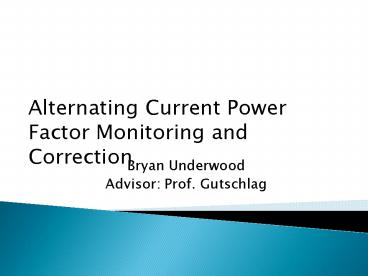Bryan Underwood - PowerPoint PPT Presentation
Title:
Bryan Underwood
Description:
Alternating Current Power Factor Monitoring and Correction ... of the electrical load in the United States is due to AC electric motors3 According to the U.S ... – PowerPoint PPT presentation
Number of Views:45
Avg rating:3.0/5.0
Title: Bryan Underwood
1
Alternating Current Power Factor Monitoring and
Correction
- Bryan Underwood
- Advisor Prof. Gutschlag
2
Power Factor
Power Factor is the ratio of the active power to
the apparent power P.F.
Complex Power Diagram
3
Power Factor (cont.)
- Poor power factor is due to inductive loads such
as induction motors in air conditioners and
refrigerators - A very low power factor usually results in the
power company charging more on a utility bill
4
Standards
- Ameren Illinois requires Residential customers
(rate DS-1) and Light Industrial Non-Residential
customers (rate DS-2, DS-3) to maintain a power
factor of 0.90 while Heavy Industrial
Non-Residential customers (rate DS-4) must
maintain a power factor of 0.951
5
Power Company Charges
- If the power factor falls below the minimum
specified by Ameren and ComEd, they require
corrective devices to be installed - Pacific Gas and Electric (PGE) charges 0.6 more
on a utility bill for each percentage point below
a power factor of 0.852
6
Industry Averages
- About 60 of the electrical load in the United
States is due to AC electric motors3 - According to the U.S. Energy Information
Administration (EIA), only about 25,000 out of
200,000 manufacturing companies participate in
power factor correction (PFC)4
7
Reasons for Power Company Surcharges or
Requirements for Power Factor Improvement
- Increased I2R losses in transmission lines due to
the additional current requirements needed to
provide excess reactive power reduces efficiency,
capacity, and profit margins - Increased current requirements result in higher
transmission line, transformer, and switch gear
current ratings
8
Power Factor Correction (PFC)
- Usually done by capacitor banks
- Generate negative reactive power
http//accessscience.com/content/Reactive-power/80
2370
9
Equipment
- Hampden Type WRM-100 3-Phase Motor
- 220 V
- 1.4 A
- 1725 RPM
- 1/3 HP
10
Motor Efficiency and Power Factor
11
Equipment (cont.)
SATEC PM172E-N 3-Phase Programmable Power Meter
12
Software
- SATEC Power Analysis Software V1.4 Build 5
- Configure basic setup of meter, set trigger
points, and view event logs and waveforms
13
Alternative Meters
- Larger meters have more relay inputs and outputs
to permit more incremental values of capacitors
to be switched as needed for more precise control
of the power factor - More programming options provide more robust
control for better power factor correction
directindustry.com
news.thomasnet.com
14
Relays
Potter Brunfield KRPA-11AG-120 Power Relays
15
Capacitor Banks
- Capacitance is added to each line and can be
varied from 1.6uF to 50uF
16
Damping Resistors
- Resistors are placed in series with the capacitor
banks to reduce inrush currents
17
Damping Resistors Loses
- Current through resistor
- with 10uF Capacitor
- Power losses
- Current w/ 20uF
- Power losses
- Current w/ 30uF
- Power losses
18
System Diagram
19
System
20
Capacitor Bank Switching
- Relay coils are energized from SATEC meter when
the power factor drops below a certain point - Line current is also monitored to ensure no
switching occurs when no load is present - Capacitors are added to the circuit in parallel
with the motor - Placed in parallel to maintain the same line
voltages into the motor - Power factor can be varied over any desired range
to avoid electric utility company charges - Project system maintains a power factor of above
0.98
21
Flow Chart
22
Experimental Results
-0.9
23
Whats Next?
- Complete the theoretical circuit model and
compare with experimental results - Research how the meter calculates its values
- Write tutorial on how to use power meter
- Will use as an appendix for final paper
- Write final paper
24
Questions?
25
References
- 1 http//www.ameren.com/sites/aiu/Rates/Documents
/AIel14rtds4.pdf - http//www.ameren.com/sites/aiu/Rates/Documents/A
Iel48rdimf.pdf - 2 http//www.pge.com/includes/docs/pdfs/mybu
siness/customerservice/energystatus/powerquality/p
ower20factor--revised-8-9-07.pdf - 3 http//www.pge.com/includes/docs/pdfs/mybusiness
/customerservice/energystatus/powerquality/power2
0factor--revised-8-9-07.pdf - 4 http//www.eia.gov/emeu/mecs/mecs2002/dat
a02/excel/table8.1_02.xls
26
System Values at Various Loads
Motor Load Apparent Power (VA) Power Factor Active Power (W) Motor Speed (RPM)
No Load 345 0.312 107 1777
¼ Load 354 0.435 156 1705
½ Load 394 0.554 216 1683
¾ Load 419 0.658 276 1677
Full Load 520 0.776 405 1585































